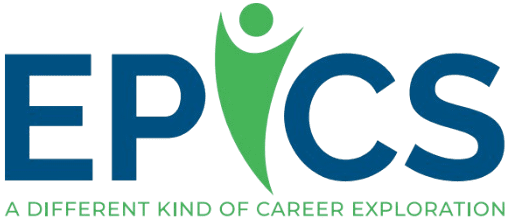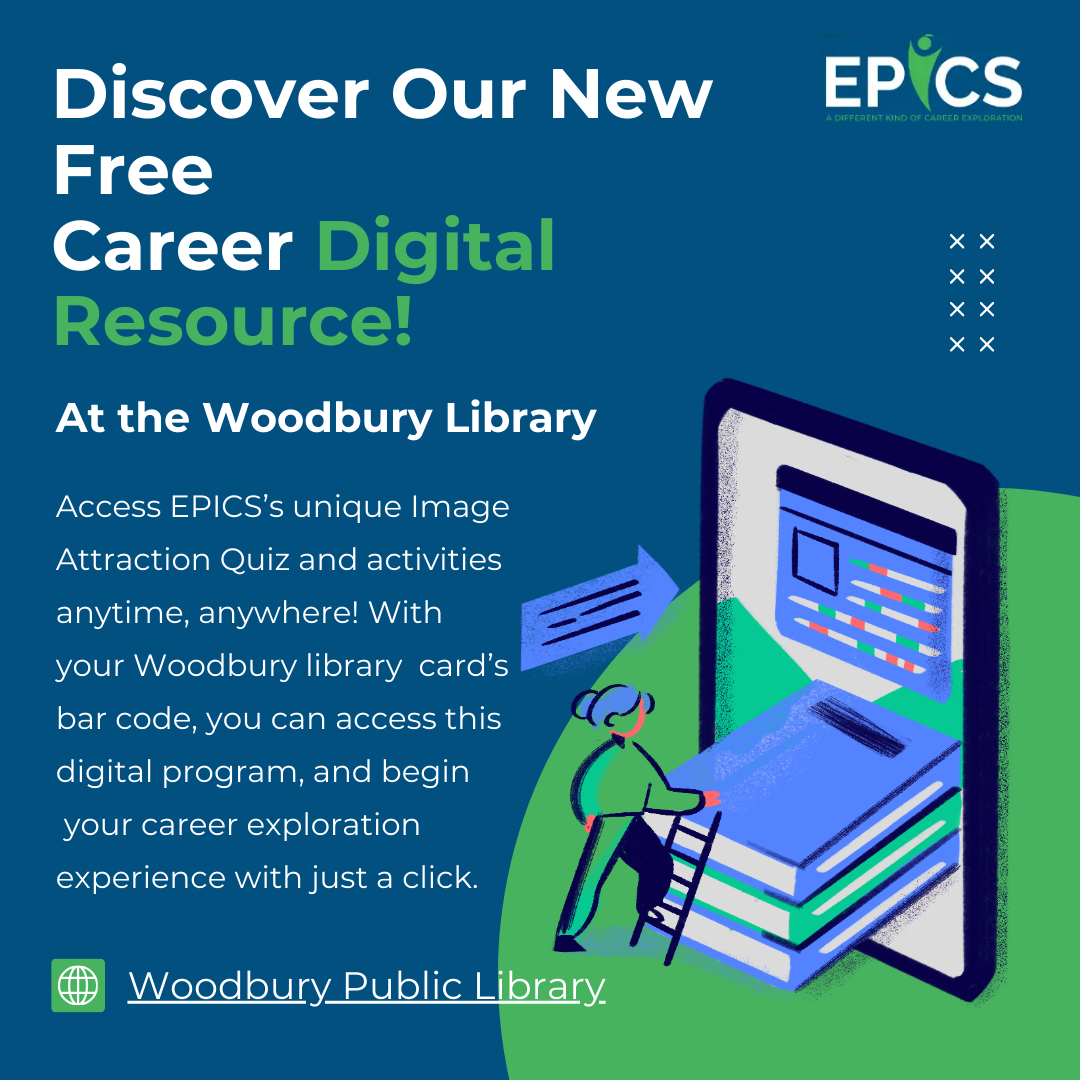MEDIA KIT
Use the editable Canva links below the flyers and posts to rewrite them in your voice. The same applies to any of the templates we created. Don’t be afraid to let your creative flair shine
Press releases, email templates, how to's… and more
Feel free to edit these templates, add your info, and if they are better than ours, please share your creation with us! We are better together.
Press releases
FOR IMMEDIATE RELEASE
[Library Name] Introduces Innovative Career Discovery Tool “EPICS” for Patrons
[City, State] – [Date] – [Library Name] is thrilled to announce the launch of an exciting new resource designed to help patrons explore and discover their ideal career paths. The EPICS tool, an online-based career assessment platform, is now free to all library patrons. This tool revolutionizes career exploration by using an intuitive, picture-based quiz that makes it accessible and engaging for users of all ages and backgrounds.
Unlock Career Potential with EPICS
Unlike traditional exams that rely heavily on text, the EPICS tool provides a unique, interactive experience, from picture-based assessments to creative activities that help patrons access their intuition and identify the career fields most likely to bring them happiness. Patrons can easily find career options that match their work environment preferences and interests, no matter their reading level or learning style. This innovative tool is ideal for visual learners and those who find traditional assessments challenging. However, it is also useful for anyone seeking to discover career paths likely to lead to personal happiness.
Key Benefits for [Library Name] Patrons:
· EPICS is for all learners, even those with learning challenges.
· Interactive Image Attraction Quiz: Use visual literacy to identify strengths, skills, and interests.
· Interactive activities to dig deeper into personal and professional needs.
· Your EPICS Journey map and planner to keep you on the right career path.
[OPTIONAL] Besides the digital platform, [Library Name] offers onsite career exploration workshops. These workshops are designed to provide hands-on, interactive experiences that complement the online resources available through the online tool. Participants will have the opportunity to:
· Engage in Creative Activities: Enhance intuitive responses and creativity through cognitive science-based exercises.
· Participate in Group Discussions: Share experiences, gain insights from peers, and build a supportive network.
About [Library Name]
[Library Name] has been a community cornerstone since [Year of Establishment], offering various services and resources to support lifelong learning, cultural enrichment, and community engagement. With the addition of EPICS, [Library Name] continues to innovate and expand its offerings to meet the evolving needs of its patrons.
For more information about EPICS, please visit [Library Website] or contact [Library Contact Information].
Contact: [Your Name];p[;
[Your Title]
[Library Name]
[Phone Number]
[Email Address]
[Library Website]
Fund raising letter
[Library Name]
[Library Address]
[Date]
Dear [Library Supporter/Community Member],
At [Library Name], we believe that a library is more than books—it’s a place where dreams take shape, goals are set, and lives are transformed. Today, we’re reaching out to invite you to help us expand that mission in an exciting new way.
We’re raising funds to bring EPICS, a unique visual digital career exploration resource, to our community. EPICS helps people of all ages—students, job seekers, and career changers—discover fulfilling career paths through an engaging, image-based quiz and activities that match their strengths, values, and passions.
Why EPICS Matters:
· It reaches everyone, especially visual learners, English language learners, and anyone who benefits from intuitive, accessible tools.
· It supports local teens choosing their first jobs, parents re-entering the workforce, and neighbors ready for a career change.
· It’s available anytime, anywhere—helping people grow their futures on their own time.
Why Your Support Matters:
By helping us fund EPICS, you’re helping us expand our library’s role as a vital community resource. More people will visit the library, use our services, and share in our mission of lifelong learning and growth. Increased usage and impact can help us secure even more grants and gifts in the future—your gift makes a difference far beyond today.
Together, We Make Dreams Possible
Your contribution—large or small—will help us reach our goal to make EPICS available to everyone in our community, free of charge.
Please consider donating today.
Together, we can help neighbors discover work that lights them up inside and makes their soul sing.
To make your tax-deductible gift, visit [donation link], or drop by the library to donate in person.
Thank you for believing in our library, and in the potential of every person we serve.
With gratitude,
[Library Director’s Name]
[Library Name]
[Contact Information]
Additional library resources:
Library Career Exploration Resources: RIASEC, Books, and Magazines
Help your patrons explore meaningful careers using these curated resources centered around the Holland Codes (RIASEC), career theories, and real-world insights.
📚 Books on Holland Codes (RIASEC) & Career Theory
Located in Dewey Decimal Classification: 331. 331.702 – 331. 7
What Color Is Your Parachute? by Richard N. Bolles – A classic with values and interest assessments.
Do What You Are by Paul D. Tieger – Connects personality types with career paths.
Now What? by Nicholas Lore – Great for teens and young adults.
The Career Guide for Creative and Unconventional People by Carol Eikleberry
Works by John Holland or books on Holland’ s Theory of Vocational Choice
🧱 Career Exploration & Planning Books
Typically found in YA 331. 7 or Adult Nonfiction 331. 7
Career Match by Shoya Zichy
Roadmap by Roadtrip Nation
Careers by DK Publishing – Visual guide with job information by interest area.
Occupational Outlook Handbook – U. S. Department of Labor’ s essential guide (print or online)
🧑 🎓 Career- Specific Reference Guides
Located in Reference or the Career Sections:
Peterson’ s Career & Test Prep Guides
Vault Career Guides – In- depth looks at specific fields
Ferguson’ s Career Guidance Center (Database)
Encyclopedia of Careers and Vocational Guidance – Includes RIASEC codes
📰 Career- Focused Magazines & Periodicals
Available in print or digitally via Libby/Flipster:
Fast Company – Innovation, leadership, and the future of work
Entrepreneur – Startups and self- employment
Money – Personal finance and career earnings
Occupational Outlook Quarterly – Career outlook features
Inc. Magazine – Workplace and industry trends
📂 Online Databases & Tools (Library Card Access)
O* NET Online – Explore careers by RIASEC type and skills
LearningExpress Library – Test prep, career help, and skill- building
Brainfuse JobNow – Resume tools and live coaching
CareerOneStop – Tools and guides provided by the U. S. Department of Labor
Gale Presents: Peterson’ s Test and Career Prep – Test prep and career search tools
Book marks or postcards- your choice


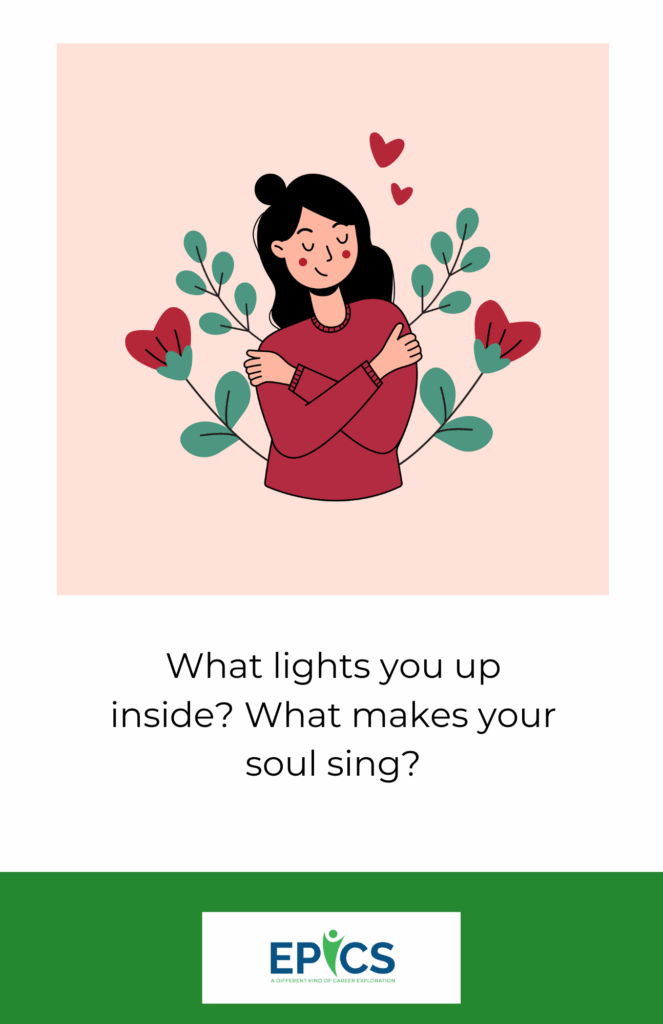
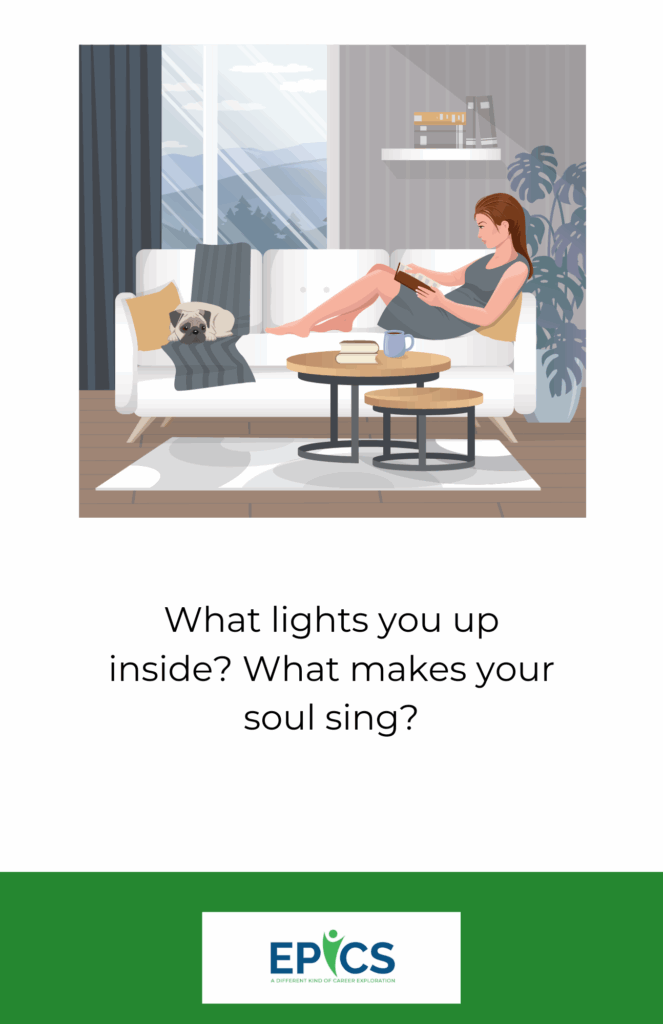
Library program guides:
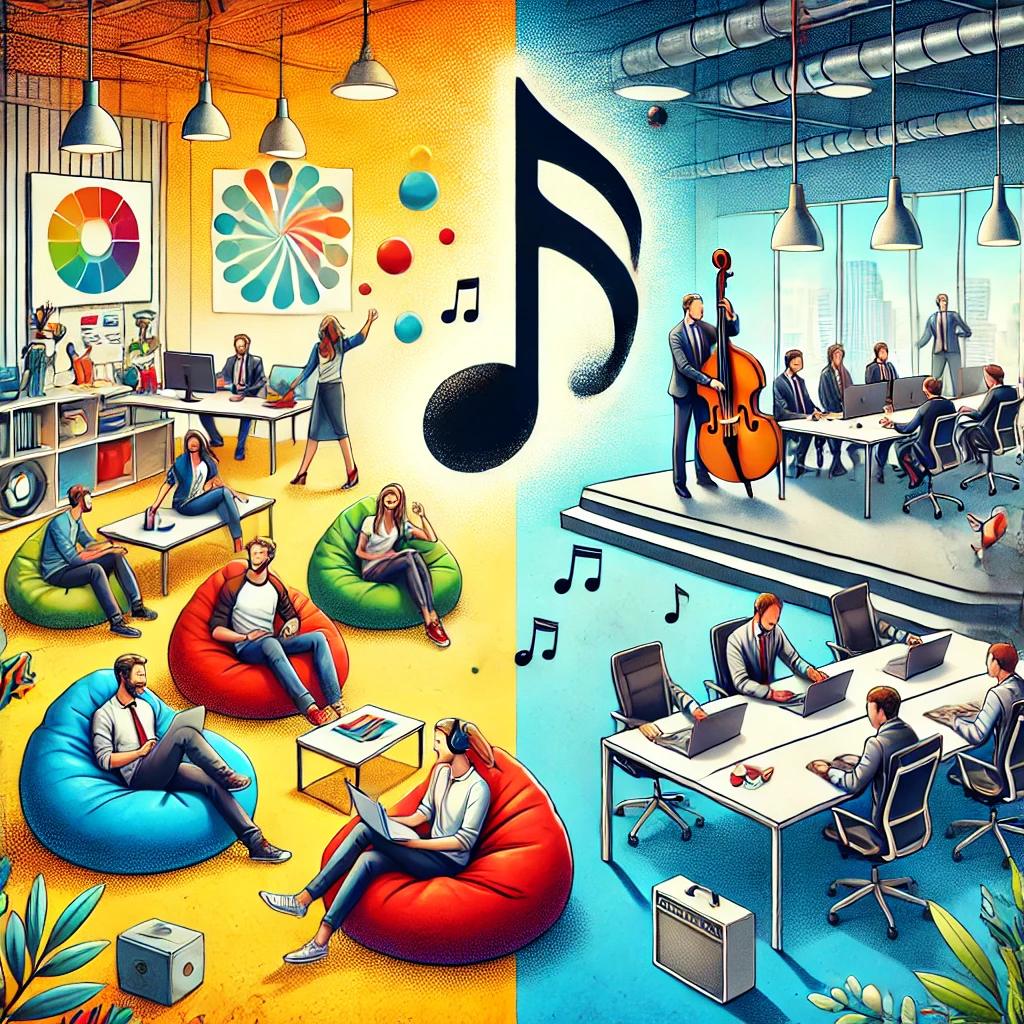
Facilitation Guide for “Corporate Culture Exploration” Group Activity
· Goal of the Activity:
- To help participants identify and reflect on what corporate culture means to them and how it aligns with their career goals and personal values.
1. Introduction (5 minutes)
- Welcome & Introductions:
- Welcome, everyone, to the activity. Briefly explain the purpose of the session: to explore what kind of work environment best supports their career satisfaction and personal growth.
- Encourage participants to share a little about themselves (e.g., what brought them to this activity or what they hope to gain from it).
- Note that this activity is designed to help them understand the values that will enable them to thrive in a workplace.
- Explain Corporate Culture:
- Define corporate culture for the group in simple terms: “Corporate culture is the environment or vibe of a workplace. It includes things like company values, communication styles, and the support they provide for employees.”
- Highlight the importance of identifying a work environment that aligns with personal values for long-term satisfaction.
2. Group Activity (10–15 minutes)
Distribute Worksheets:
o Hand out the “Corporate Culture Exploration” worksheets.
o Ensure each participant has a pen or marker and encourage them to follow along as you guide them through the activity.
· Instructions for Young Adults and Job-Transitioning Adults (Group Split):
o For Young Adults: Focus on the “Top Priorities” section, where they identify what’s most important in their first job or internship. Discuss workplace values like flexibility, creativity, and self-care.
o Read the examples of corporate culture elements (e.g., career growth, communication avenues, self-care, etc.).
o Select the top three things that matter most to you in a workplace.
o Tip: Think about the kind of workplace where you would feel comfortable, energized, and motivated to grow.
o For Job-Transitioning Adults: Guide them to think about what aspects of corporate culture are crucial as they transition to a new job. This might involve looking at things like career growth opportunities, work-life balance, and company support systems.
Tip: Allow participants to circle or highlight the top three elements that resonate with them most. Encourage them to think of past jobs or experiences for context.
3. Reflection and Group Discussion (15 minutes)
- Group Reflection Questions:
- Ask the group to reflect on the questions from the worksheet and allow them to share their thoughts with the group:
- “Why are these priorities important to your career satisfaction?”
- “What type of work environment do you see yourself thriving in?”
- ” What specific workplace values (e.g., collaboration, creativity, flexibility) would support your success and make you feel at ease?
- Use these questions as a discussion starter. Invite a few participants to share their responses and encourage others to speak up if they agree or have similar thoughts.
- Ask the group to reflect on the questions from the worksheet and allow them to share their thoughts with the group:
- Group Sharing:
- If time allows, have participants discuss in pairs or small groups, then share one key takeaway with the larger group. This fosters peer-to-peer learning.
4. Next Steps and Action Plan (10 minutes)
- Action Planning:
- Ask participants to review the “Next Steps” section of the worksheet, where they will write down two ways to research companies or workplaces that align with their priorities.
- For example: “Look for internships at companies with a focus on work-life balance and self-care.”
- Use job sites and company reviews to explore their corporate culture before applying for roles.
- Ask participants to review the “Next Steps” section of the worksheet, where they will write down two ways to research companies or workplaces that align with their priorities.
- Suggestions to guide them:
- Researching companies on job sites.
- Reaching out to contacts in their network for informational interviews.
- Exploring company websites for insights into their culture (e.g., mission statements, employee reviews, etc.).
- Suggestions to guide them:
- Facilitator Tip: Provide suggestions or share your own tips on researching corporate culture. For example, encourage them to check platforms like Glassdoor or Indeed for employee reviews or visit a company’s social media pages for a glimpse of their culture.
5. Bonus Activity: Scenario Role-Playing (10 minutes)
- Role-Playing Exercise:
- Divide participants into small groups and assign them the “Scenario Bonus Activity.” Have them practice answering the following interview question:
- “What kind of corporate culture are you looking for?”
- Allow them a few minutes to prepare their answers. Then, invite each group to share their answers with the larger group.
- Divide participants into small groups and assign them the “Scenario Bonus Activity.” Have them practice answering the following interview question:
- Debrief:
- After each group shares, ask the group what they noticed about the answers. Did anyone mention unexpected values? Were the answers more focused on benefits or on work-life balance?
6. Wrap-Up & Final Reflection (5 minutes)
- Summarize the Key Takeaways:
- Recap the activity’s goal: understanding what kind of workplace culture will make them feel fulfilled and motivated in their careers.
- Remind participants to take the reflections they worked on today and use them to guide their job search or career transition. Encourage them to revisit the action items if they require further guidance.
- Closing Question:
- Ask participants: “What’s one new insight you learned about your ideal work environment today?” This final question invites reflection and encourages participants to consider how they can apply the activity in real-life situations.
Additional Tips for Facilitators:
- Time Management: Monitor the clock to ensure discussions stay on track. If time is tight, limit discussion to a few responses per question.
- Encouragement: Encourage everyone to participate, but respect those who prefer to listen. Ensure a comfortable, non-judgmental atmosphere.
- Adaptability: Be prepared to adjust according to the group’s needs. Some groups may need more time to reflect individually, while others may be eager to dive into discussion.
This guide ensures that facilitators can confidently lead a group activity that helps participants explore corporate culture and align their values with potential workplaces.

Workshop: Building Your Brand through Creative Exploration
Objective:
Participants will explore their brand by integrating appearance, first impressions, and style with creative activities. This workshop emphasizes self-expression through visual tools, such as collaging and crafting, combining right-brain activities with the intellectual exercise of personal branding.
Materials Needed:
Magazines, colored markers, glue, scissors
Large poster boards or collage paper
Printed worksheets from the “Branding Yourself” document
A space for group work with tables (around 5 people per table)
Flip charts and markers for group brainstorming
Workshop Structure:
Introduction (10 minutes)
Welcome participants and introduce the concept of personal branding.
Brief discussion on how appearance and first impressions can influence professional image.
Note that a creative and visual approach will be used to explore personal branding.
Warm-Up Activity (10 minutes)
Start with a simple icebreaker where participants introduce themselves by name, profession, and one aspect of their appearance or style they believe represents them well.
Ask them to briefly share their feelings about their professional appearance.
Collage Activity (25 minutes)
Goal: Create a visual representation of their ideal professional look.
Participants will:
Select images from magazines or Pinterest (if digital access is available) that represent their aspirational style for work.
Consider elements such as work attire, grooming, and digital presence from the document.
Use collage materials to craft a personal style vision board.
Please encourage them to find items and styles that reflect their personality and career goals, blending professional and personal elements (e.g., outfits that match their field but with an individual flair).
Reflection: While collaging, reflect on how their current image aligns with their career ambitions and what adjustments could be made.
Branding Reflection (15 minutes)
Following their collage, students should write down three words they want to be associated with (from the “Define Your Brand in 3 Words” activity on Page 5).
Invite selected participants to share their 3-word brand statement and explain why they chose those words.
Group Discussion: First Impressions & Energy (20 minutes)
Divide into small groups (5 people each) to discuss how first impressions influence interactions (networking, interviews, etc.).
Encourage sharing personal stories where first impressions impacted professional relationships.
Have each group brainstorm what “good” first impressions look like, creating a quick sketch on a flip chart that illustrates body language, facial expressions, and communication styles that convey trustworthiness, competence, and likability.
Personal Style Statement (15 minutes)
Ask participants to craft their Personal Style Statement, reflecting how they want to present themselves professionally, inspired by their collage.
Example: “I want to be seen as approachable and creative. I show this through relaxed yet polished outfits and open body language.”
Final Reflection and Sharing (15 minutes)
Have each person reflect on potential changes to better align their brand with their values and goals.
Encourage participants to share one actionable step they will take after the workshop, such as updating their LinkedIn photo or reworking their wardrobe.
Wrap-Up & Homework Assignment (5 minutes)
Summarize the activities of the day.
Prompt participants to complete the worksheet as homework: refining their personal brand through small changes, such as conducting a social media audit, crafting an elevator pitch, or practicing a networking script.
Remind them that consistency in appearance, communication, and actions is key to personal branding.
Note: This workshop combines right-brain creativity (through collaging) with the cognitive aspects of personal branding. The goal is to make the branding process more engaging and visual, helping participants better connect with and articulate their unique personal brand.
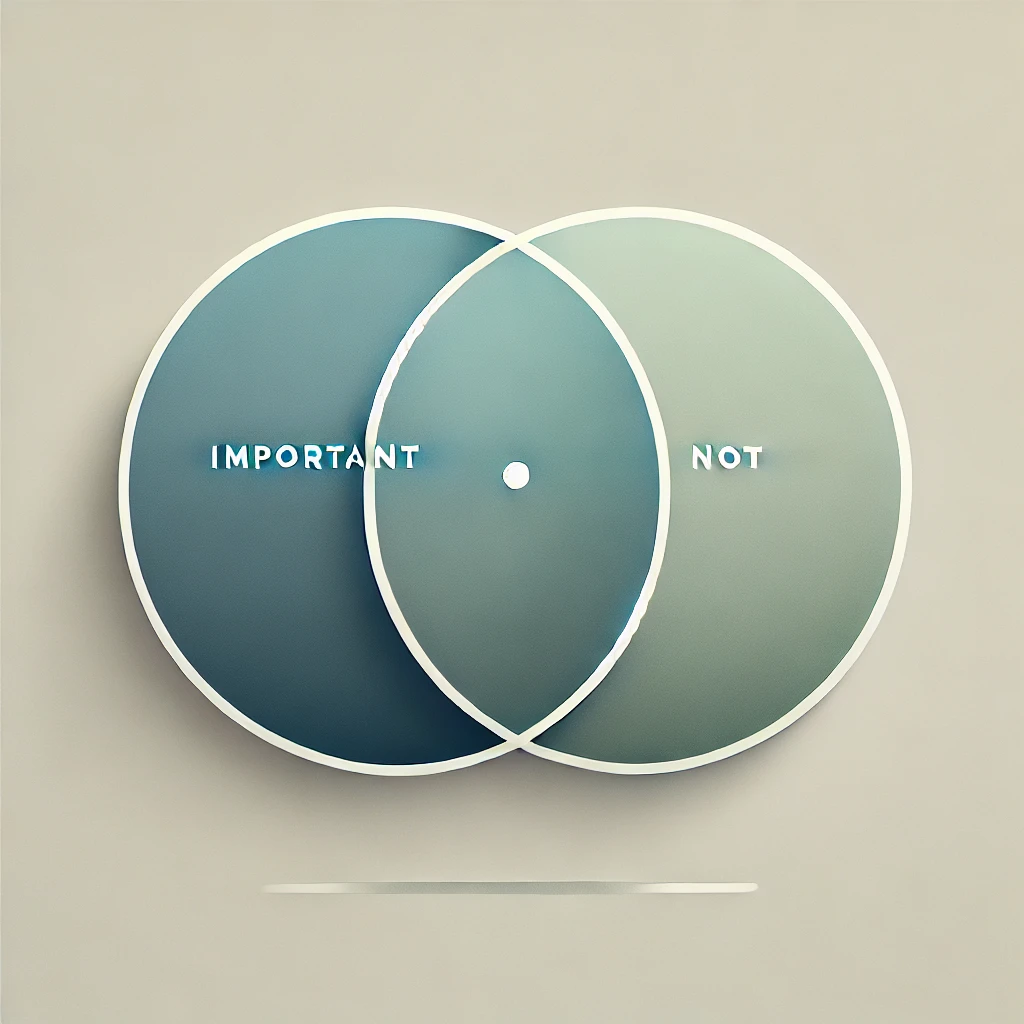
Workshop: Exploring Your Career Values
Objective:
In this workshop, participants will examine their values to identify what they want (and don’t want) in their future careers. This activity will help individuals move toward a more satisfying career path and gain a deeper understanding of what truly matters when selecting a job or work environment.
Workshop Setup
- Group Division: Divide the group into five teams of two participants each at a table. Each table will work together, sharing its insights and reflections.
- Materials Needed:
- Common value list(printed for each participant)
- Large Venn diagrams (printed and available for each group)
- Markers, pens, and paper
- A timer or facilitator to keep track of time
Activity Instructions
Step 1: Cut Out Your Values (10 minutes)
- Each participant will receive a list of values people might care about in their job environments.
- Take a few moments to consider the values and reflect on which ones stand out to you personally. Ask yourself: Which of these values do I feel strongly about? Which of them are important for me to thrive in my career?
Step 2: Place Values in the Venn Diagram (15 minutes)
- On each table, provide a large Venn diagram with three sections:
- Circle 1: Important – Values you believe are crucial for your career. These are things you truly need to thrive.
- Circle 2: Not Important – Values you don’t prioritize in your ideal work environment.
- Overlap Area – Values that could go either way, depending on the situation or stage in your career.
- As a group, discuss and decide where to place each value. For example, if “Creativity” is crucial to one person, it might go into the important circle. If another feels it is unnecessary, it may be classified as Not Important.
- Each person should place their values individually but discuss and reflect on the shared decisions as a group.
Step 3: Group Reflection and Discussion (20 minutes)
- Once everyone has placed their values, the group should reflect on the following questions:
- What surprised you?
- Which values ended up in the Important circle? Were there any values you didn’t expect to feel so strongly about?
- What didn’t resonate?
- Which values ended up in the Not Important circle? Why do you think those values didn’t resonate with you?
- The Overlap Area
- Which values landed in the Overlap Area? What does this say about your flexibility or uncertainty in your career path?
- Looking Ahead
- How do these insights help you think about the work environment where you would feel most satisfied and successful?
- Are there specific careers you’ve considered that align (or don’t align) with your identified values?
- What Do You Want in Your Career?
- Imagine a future job that truly fulfills you. What elements of your values would you want to see in your everyday career life? What values would you be willing to compromise on?
- What surprised you?
- Each group member will have a chance to share their personal reflections, fostering deeper understanding.
Step 4: Share Insights (10 minutes per table)
- Each table should appoint one person to share a summary of their group’s findings with the larger group.
- As a facilitator, you may want to ask each table to highlight:
- The most common values were identified as important or not important across all participants.
- Any notable differences in priorities and how those can reflect diverse career paths and environments?
Closing Discussion (10 minutes)
- Gather all groups together for a larger discussion.
- How did it feel to identify and reflect on these values together?
- Are there any new insights that can help shape career paths moving forward?
- What can each participant take away from this activity regarding future career planning?
Why This Activity Matters
- Knowing your core values helps guide career decisions that are authentic to who you are. This reflection allows participants find work that aligns with their personal and professional vision, ensuring a fulfilling and motivated career path.
This group-based workshop setup will encourage discussion and sharing of insights while allowing for personal reflection
